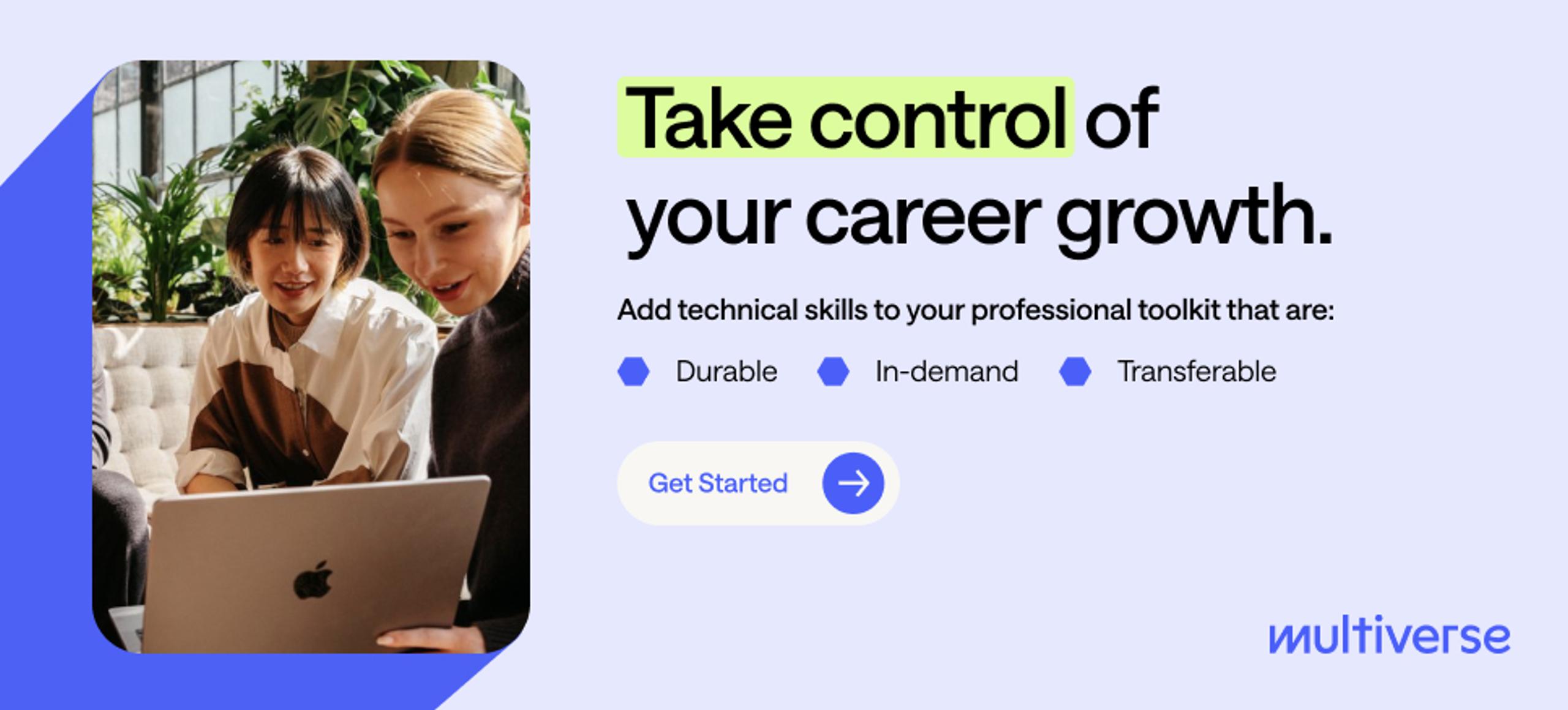Like solving problems? Have natural disposition toward technology? Then a career in data analysis could be for you.
A typical Data Analyst salary is around £8,000 more than the average full-time UK wage. And Data Analyst is fast becoming one of the crucial jobs of the future.
Keep reading to learn more about the role and how to make data analysis a core component of your career — whether you're an entry-level professional or a fledgling junior analyst.
What is a Data Analyst?
A Data Analyst collates, cleans, and reviews raw data. In some roles, Data Analysts may use data to solve business problems and make decisions. In others, they may share insights about trends or anomalies to help their colleagues create data-driven solutions to business problems.
In either case, a Data Analyst should focus on making it easier for colleagues and stakeholders to understand complex data.
Responsibilities
A Data Analyst’s responsibilities include:
- Finding, cleaning, and organising raw data
- Spotting trends, patterns, and irregularities in data
- Making raw data easy for non-specialists to understand
- Presenting and reporting upon data insights
- Helping Business Analysts build data-led processes and systems
- Keeping up with industry standards, tools, and emerging technology like Artificial Intelligence (AI)
Skills
Data Analysts will typically have the following skills:
- Mathematical understanding: Linear algebra, statistics,and probability are crucial for data analysis.
- Problem-solving: You find ways to solve project and technical challenges.
- Technical ability: You use SQL (Structured Query Language), Microsoft Excel, and data visualisation techniques.
- Database basics: You can manage and navigate databases using database management systems (DBMS).
- Business acumen: You know and use the entire data analytics process to meet business needs.
- Communication: You can share data insights with non-specialists through verbal, visual, and written communication.
How to start (or grow) your Data Analyst career
To become a Data Analyst, you’ll need to understand data analysis basics, SQL, Excel, and more. Here’s how to get a head start — or get ahead — on your Data Analyst career path.
1. Master data analysis basics
To become a Data Analyst, you must first learn the basics of data analysis. Learning the basics won’t just help you start your career path. It will also help you answer different questions and develop more advanced techniques. Plus, you’ll have a solid foundation to build upon should you want to progress in your career.
When it comes to data analysis, understanding the two primary forms of data analytics — qualitative and quantitative — is a great place to start. You’ll want to learn what they are and their differences. Here’s a quick lesson at a glance.
Quantitative analytics uses data you can measure with numbers like costs, revenue, and projections. Meanwhile, qualitative analytics uses data you can’t measure with numbers, like data gathered from customer satisfaction surveys.
You can use qualitative and quantitative data to answer different business questions. Quantitative data will help you answer ‘how much,’ ‘how often’ and ‘how many’ queries. In contrast, qualitative data can help you discover how customers interact with a company and the ‘why’ behind specific interactions.
Pro tip: To take this further, start learning specific data analysis methods like ‘cohort analysis’ (quantitative) or ‘discourse Analysis’ (qualitative).
2. Analyse real data
The best way to learn any new skill is to go beyond theory and put learning into practice. In the case of data analytics, this means experimenting with real data sets in a controlled environment.
Think of it this way: when you first start bowling, using the bumpers means you stay in the lane as you learn. That helps you build confidence and get better over time. The ‘bumpers’ here are existing data sets, which you can use to practice different analysis techniques.
The data is real, but it has no direct consequences to an employer, which means you can experiment without ‘breaking’ anything. You can use this to build your confidence, learn to spot trends and practice more advanced data analysis.
Pro tip: To get started, download and use free governmental data sets from the Office of National Statistics(opens new window) (ONS). You can also find similar open data(opens new window) published by the central government.
3. Learn SQL
As a Data Analyst, you’ll frequently interact with databases and database management systems. So understanding the ‘language’ they speak is a must. SQL is a type of programming language that you can use specifically for relational databases.
Data Analysts will typically use SQL for querying, updating, and deleting data. This includes tasks like selecting all records from a table, updating existing data, or managing access to database objects. You can also use SQL to add quality control measures, assuring data upload quality.
Pro tip: Aside from having proficiency in SQL, you may need to learn other programming languages like Python, R, and Java. But this depends on the specifics of your role. If you’re new to SQL and programming languages, YouTube tutorials are a great entry point. Alternatively, you can find free beginner courses on sites like Codecademy(opens new window).
4. Master Excel
Data Analysts use Microsoft Excel for data manipulation, simple analysis, and reporting. Excel's pivot tables and formulas are valuable tools for quick data exploration. The right Excel knowledge makes it easier to clean and organise data.
To become a Data Analyst, focus on developing these Excel skills:
- Aggregating and joining data
- Pivot tables, visualisations, and data cleaning
- Using AI within Excel to work more efficiently
Pro tip: As with SQL, plenty of YouTube videos online can help you get started with the spreadsheet software. Then, Microsoft offers Excel video training(opens new window), too. You could also download free governmental data sets and experiment with formulas and pivot tables within Excel.
5. Practise data visualisation
Being a Data Analyst isn’t just about the insights you find. How you show your findings to colleagues and stakeholders also matters. Data visualisation can help you make complex data accessible to non-specialists—a vital part of the Data Analyst’s role.
You can create various data visualisations (i.e., graphs and charts) in Excel. A business intelligence tool like Tableau can also help you explore and communicate insights from data. PowerBI is another popular data visualisation tool that can take you beyond basic graphs and charts.
Pro tip: If you have Microsoft 365, you can experiment with data visualisation in Excel as part of your subscription. PowerBI and Tableau aren’t free software, but PowerBI is the most cost-effective. You can also practice basic data visualisation techniques for free using something like Google Sheets(opens new window).
6. Rehearse presenting your findings
Aside from data visualisation, your presentation skills are crucial to help non-specialists understand data and insights. Some people are naturally more confident and excel when presenting. But even if that’s not you, don’t worry—presenting is a skill you can hone with practice.
To practice presenting your findings, start a personal data visualisation project. That will give you data to explore, insights to visualise, and information to share. You can present these insights in blog posts, reports, or mock presentations to family, friends, or tutors.
When you present, explain the insights you found (i.e., trends) and how you found them (i.e., your analysis process). You should also explain why your findings matter and how they impact the project.
Pro tip: Remember, your audience is non-technical and unfamiliar with data. So speak clearly without jargon and use data visualisation to break down your findings. If you want to take it beyond charts and graphs, experiment with storytelling to make your conclusions more engaging.
7. Become an apprentice with Multiverse’s Data Fellowship
Without the proper support, becoming a Data Analyst — or upleveling your data skills — can take so much longer than it has to. Choosing a university path can cost you up to £9,250 per year just for tuition fees. Not to mention the opportunity costs of taking a career break to attend a full-time programme if you're already working.
The good news: If you're a junior Data Analyst looking to progress into mid or senior-level roles, earn a promotion, or just increase your data savviness, Multiverse can help. Through our Data Fellowship or Advanced Data Fellowship, junior or new Data Analysts can earn a nationally recognized qualification on the job without having to put their careers on hold. Also, because Multiverse partners with employers to sponsor programme costs, our apprenticeships cost nothing for learners.
Our data programmes help learners deepen expertise of highly sought-after technical skills, including Python, machine learning, data governance, and more. If you're interested in learning more, fill out our quick application form(opens new window).
Pro-tip for career starters: Multiverse also offers apprenticeship programmes for entry-level learners and data enthusiasts. But unlike our upskilling programmes for junior Data Analysts, you have to be accepted by an employer, not Multiverse, to do such a programme.
This path would allow you to complete a valued Multiverse apprenticeship in conjunction with your responsibilities in a new role at a company in the UK.
The bottom line: If you're looking for your first job in data, consider searching and applying for apprenticeships in England here(opens new window).
8. Build a portfolio of data analysis work
A portfolio of your data analysis work demonstrates your capabilities at every stage of your Data Analyst career. You can improve your portfolio whenever you work on a new project or advance throughout your career. Using Multiverse programmes as an example, let’s put building a portfolio into practice.
As a Multiverse Apprentice, we’ll work with you to build a strong portfolio. As an aspiring or junior Data Analyst, you might start a Data Fellowship apprenticeship. You’ll gain a portfolio of work full of real-life projects showing you understand database fundamentals and have technical skills. Your portfolio will also demonstrate relevant experience for a new role or a career progression.
You could move onto the Advanced Data Fellowship programme if you want to progress and upskill as a Data Analyst. You’ll qualify with a body of work demonstrating your capability with advanced analysis methods and ability to deliver real-world business results.
Pro tip: Besides gaining a portfolio, both programmes offer industry-recognised certifications, further showing your competence.
9. Apply for Data Analyst roles
If you’ve worked on developing relevant skills and feel confident in your abilities, it could be time to start applying for Data Analyst roles. To simplify the application process, one of the first things you should focus on is developing your CV. If you’ve never crafted a CV, you can use a CV template to help.
Here are a few expert tips to help you get started:
- Aim to use keywords from the job description—especially for the tools, skills, and programming languages. You can add these to your CV summary, work experience, and skills sections.
- Use bullet points and shorter sentences to help recruiters scan your CV at a glance.
- Try to stick to one page, two pages max.
- Using an image of yourself on a UK CV is uncommon and can distract from your skills and experience. The safest option is to avoid doing so.
- Proofread your CV for spelling and grammar errors before applying for a job.
How long does it take to become a Data Analyst?
How long it takes to become a Data Analyst depends on your chosen path, so let’s compare the apprenticeship vs. university route.
If you choose to study a Bachelor of Arts (BA) in Computer Science at university, you could spend four years in a lecture hall. That’s before you even start your job search, apply for Data Analyst vacancies, get an interview, and (hopefully) land your first role.
In contrast, when you study a relevant apprenticeship, you become a Data Analyst from the start of your programme. It’s worth noting that different apprenticeship levels have varying completion times. That said, you can get the equivalent of a full Bachelor's degree in as little as three years, depending on your course structure.
What tools do data analysts use?
Here are the standard tools that Data Analysts use in their roles:
- Database management systems: This software helps users or applications access a database and work with the data. Some popular DBMS options include MySQL, PostgreSQL, Oracle Database, Microsoft SQL Server, and SQLite.
- Data visualisation tools: PowerBI and Tableau are two common software platforms. They help Data Analysts to visualise and present data-led insights in engaging ways.
- Microsoft Excel: Data Analysts use this spreadsheet software for data entry, calculations, and analysis. You can also create visual representations of data through charts and graphs.
Grow your career as a Data Analyst with Multiverse
Data Analysts must know SQL, Excel, data visualisation techniques, and a host of other skills. The Multiverse Data Fellowship programme covers all of this and more. Plus, you’ll earn an industry-recognised qualification and build a portfolio without putting your career on hold.
At Multiverse, we make it easy for you to get started(opens new window). It takes less than 15 minutes to create a profile. Our team can then double-check your eligibility and discuss apprenticeship options with your employer.







